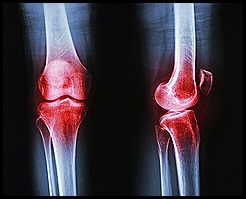 Osteoarthritis (OA), also known as degenerative arthritis, is the most common form of arthritis and involves the joint cartilage. The inflammation and degeneration can result in pain, swelling, decreased range of motion and mobility and even changes in the shape of the joint and abnormal bone growth. The knee joints are one of the most common joints affected by OA, and especially so in women.
Osteoarthritis (OA), also known as degenerative arthritis, is the most common form of arthritis and involves the joint cartilage. The inflammation and degeneration can result in pain, swelling, decreased range of motion and mobility and even changes in the shape of the joint and abnormal bone growth. The knee joints are one of the most common joints affected by OA, and especially so in women.
The current study was conducted in Iran, and involved 50 patients (40 women and 10 men) aged 50 to 70 years old who had knee OA with mild to moderate disease severity based on accepted criteria of the American College of Rheumatology (ACR).
The patients were randomly divided into 2 groups: sesame treated group and control groups. The control group received standard drug therapy of 500 mg acetaminophen twice daily and one glucosamine 500 mg/day. The study intervention group (25) received 40 g of sesame seeds, ground into a powder, per day along with the standard drug therapy, for 2 months. Patients in both groups maintained their usual diet and physical activity during the study.
The Knee Injury and Osteoarthritis Outcome Score (KOOS) and Timed Up and Go (TUG) and the Visual Analog Scale (VAS) tests were used for clinical assessments. VAS measures subjective characteristics or attitudes. In this study, VAS was used to measure the rate and intensity of the pain. O represents no pain and 10 represents the maximum pain tolerated. The TUG is used to assess a person’s mobility. It uses the time it takes to rise from a chair, walk 3 meters, turn around, walk back to the chair and then sit down again. Scores of 10 seconds or less indicated normal mobility, 11-20 seconds are within normal limits for elderly and disabled individuals and > 20 seconds means the person needs assistance. A score of 14 seconds or more may indicated they are prone to falls. The KOOS is a test specific to the knee and assesses a person’s opinions and problems associated with their knees. It measures pain, swelling, restricted range of motion and mechanical symptoms, activities of daily living, recreation function and knee related quality of life. The KOOS scores for each of the areas measured are transformed to a 0-100 scale with 0 representing extreme knee problems and 100 representing no knee problems.
After treatment, there was significant difference in pain intensity between the two groups. The mean score of KOOS in both treatment and control groups was significantly increased compared to baseline. The mean score of the TUG Questionnaire in both treatment and control groups was significantly decreased from baseline. There was no significant differences in pretreatment scores of KOOS and TUG between the two groups. There was significant difference in post treatment scores of the KOOS and TUG between the two groups.
Commentary: This study showed a positive effect of a rather simple dietary addition of 40 gm/day of ground sesame seeds, in improving clinical signs and symptoms in patients with osteoarthritis of the knee. It should be considered a good adjunct to acetaminophen and glucosamine.
Sesamin, a lignan derived from sesame seeds has been shown to inhibit pro-inflammatory cytokines involved in inflammatory factors. Oxidative stress also has a role in OA and sesame oil can increase antioxidant capacity, superoxide dismutase (SOD) and serum antioxidants including vitamins C and E. Improving antioxidant enzyme activity and improving oxidative status with sesame is a possible mechanism in improving symptoms and signs of OA.
Possible methods of delivery of this 40 gm/day of ground sesame seeds could be in a smoothie, in yogurt, on fruit or vegetable salads, and on top of cooked vegetables. A tablespoon is approximately 9 grams…so 4 plus tbsp. per day. Simple, safe, tasty, healthy, and hopefully a way to help with mild to moderate osteoarthritis of the knees (and maybe other joints!).
Reference
Sadat E, Haghighian K, et al. Effects of sesame seed supplementation on clinical signs and symptoms in patients with knee osteoarthritis. Int J Rheum Dis 2013; 16(5): 578-582.

